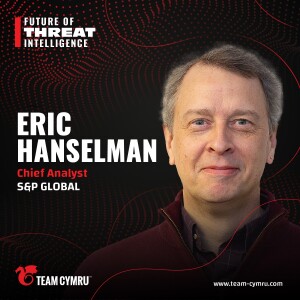
Thursday Oct 17, 2024
S&P Global’s Eric Hanselman on Integrating Threat Intelligence into Business Strategy
In our latest episode of the Future of Threat Intelligence podcast, David speaks with Eric Hanselman, Chief Analyst at S&P Global, about the critical role of threat intelligence in today’s cybersecurity landscape. Eric emphasizes the need for organizations to integrate threat intelligence operationally, moving beyond mere threat feeds to develop comprehensive threat models.
He discusses the importance of maintaining operational hygiene, building a peer ecosystem for information sharing, and aligning security strategies with overall business objectives. Eric also offers valuable insights on navigating the complexities of cybersecurity and the future of threat intelligence.
Topics discussed:
- Insights on the evolving role of threat intelligence in modern cybersecurity strategies and operations.
- How organizations must integrate threat intelligence operationally to effectively manage risks and inform day-to-day security decisions.
- Why simply having a threat feed is insufficient; understanding and updating threat models is crucial for effective risk management.
- How operational hygiene, including good backups and data protection, is essential for defending against ransomware and other cyber threats.
- The value of building a community for information sharing enhances collaboration and provides valuable reality checks among cybersecurity professionals.
- Aligning security strategies with business objectives ensures that security measures support overall organizational goals and operations.
- Looking ahead and maintaining a forward-thinking perspective is vital for anticipating future cybersecurity challenges and opportunities.
Key Takeaways:
- Integrate threat intelligence into daily operations to enhance your organization’s ability to respond to emerging cybersecurity threats.
- Develop comprehensive threat models that are regularly updated to reflect the evolving risk landscape and inform strategic decisions.
- Prioritize operational hygiene by ensuring robust data protection measures and effective backup systems to mitigate ransomware risks.
- Build a network of cybersecurity peers for information sharing to gain insights and reality checks on current security practices.
- Align your security strategies with business objectives to ensure that cybersecurity efforts support overall organizational goals and operations.
- Stay informed about emerging technologies, such as GenAI, and assess their potential impact on your security posture.
- Engage in end-user research to understand the pain points of security teams and develop solutions that address their challenges.
- Look beyond immediate threats and focus on long-term strategic planning to anticipate future cybersecurity challenges.
- Foster a culture of collaboration within your organization to enhance communication between security teams and other business units.
- Regularly evaluate and refine your security practices to ensure they remain effective in the face of evolving threats and technologies.
No comments yet. Be the first to say something!